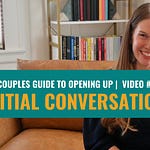As many of you know, I’m working on a book—a story about our open marriage. You may not know that my husband is struggling with it. He is proud of me for never giving up on my goal to write a book (not yet, anyway), but he doesn’t like the idea of being written about in a book. I don’t think most people would.
Did you know he was in my videos when I first started sharing stories on TikTok? I loved having him there—his perspective often balanced mine, and I think our dynamic would have strengthened the content. But social media became too public too quickly for him. Creating a video for a small audience was fine, but he struggled when my videos started getting millions of views. And he hated the comments. I’ve since removed any footage of him at his request, but I miss filming and coming up with ideas together. My husband is an intensely private person.
I, on the other hand, am an open book. Literally.
For the past year, we’ve constantly negotiated about how much of our private lives I can include in the book, which stories he’s okay with me sharing, and which are off-limits. It hasn’t been easy. At this point, he would rather I write the entire book without him and have him read it before it goes to print.
Yet, I have to talk to him about it. I need to discuss certain things. I need his help remembering details and capturing his perspective. The book content has become the topic of our marriage, a constant negotiation of too much and not enough and trying to find that elusive just right. And here’s where the tools I discuss in today’s video come in—I have used every single one of them in the past week alone.
Three Communication Devices We Created for Our Open Relationship (and Use for Everything Else Too)
(📌 The full video, with detailed breakdowns of each, is available for paid subscribers.)
1️⃣ The Ace Card – A way to signal when something is really important to you.
2️⃣ The Pause Button – A tool for stepping back when things feel overwhelming.
3️⃣ Veto – A controversial but useful way to communicate clear “no-go zones” (ideally, before conflicts arise.)
I recently had to pull the Ace Card.
A few days ago, I had repeatedly asked Rich about a specific incident from early on in our open marriage. He didn’t want to talk about it. Finally, I had to say, "This is really important to me. I only needed 15 minutes to make sure I got the details right for the book.” Once I used the Ace Card, he sat down, listened, and answered questions. He needed to understand how high of a priority the discussion was for me.
Fun fact: We used to call this the “Trump Card.” In the conversation above, I actually said, “I’m pulling the Trump card.” Old habits die hard, but we have enough politics in our lives at the moment, so let’s keep them out of marital communications for now.
And then, when I tried to sneakily (not so sneakily) bring up another tough memory, Rich pressed Pause. “Let’s pause this conversation till tomorrow.” He didn’t want to avoid the conversation entirely but needed a break.
The Veto is probably the most controversial one. In non-monogamy, a veto rule or vetoing someone is often seen as unfair—ending a partner’s relationship with someone else just because you can. But here’s the thing: it’s perfectly reasonable to veto someone else before a relationship or attachment has formed.
Early on, Rich and I used veto to set clear parameters as we figured out our open relationship. I told him, “I veto you from hooking up with colleagues. I veto you from hooking up with my close friends.” He happily agreed. It wasn’t about control but a way to communicate dealbreakers before they became problems.
And now? Rich outright vetoed one of my book stories.
"But it’s such a good story!" I argued.
"No. It’s my story, not yours. I veto you from sharing that one."
And that was that. Sorry, folks—that one is coming with me to the grave.
Three More Tools Not in the Video:
Since talking and learning about communication devices, I’ve learned some that are helpful for other couples, whether they are non-monogamous or not.
4️⃣ The Spotlight – A tool to ensure one partner gets undivided attention when they need it. “I’m struggling to explain myself and I need the spotlight on me right now.”
5️⃣ Parrots – A reflective listening technique to ensure both people feel heard. The therapist who told me about this described it as one partner repeating back what the other person says till they are both on the same page.
6️⃣ Time Boxing – Setting a time and place for a conversation and agreeing that once it’s over, it’s over.
Timeboxing has become part of our evening ritual! My husband and I spend many nights, at least a few each week, across from each other on the couch, talking. It’s how we unwind together. It’s not scheduled, but occasionally, if there’s something difficult to discuss, we agree to timebox it: "Let’s have a glass of wine on the couch. When we finish our drinks, we’re done talking for the night."
I’ll update my list eventually, I’m sure.
If you're interested in learning more about emotional vs. effective communication and expressing needs, wants, and desires, the full video is available for paid subscribers.
Listen to this episode with a 7-day free trial
Subscribe to Beyond Boundaries to listen to this post and get 7 days of free access to the full post archives.













